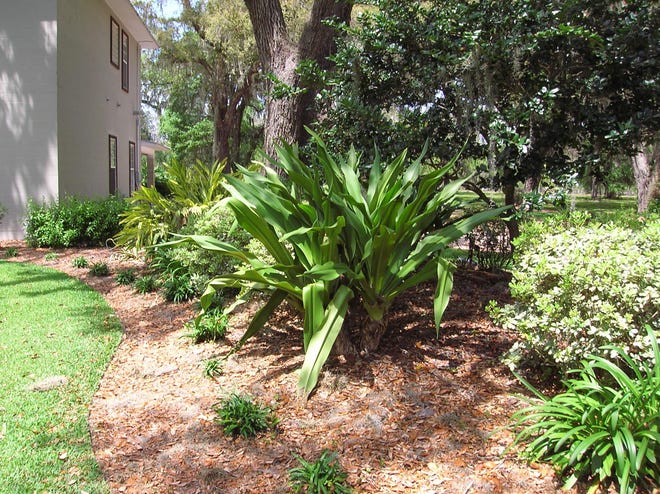Which Of The Following Statements Is Untrue About Victorian Gardens?
Lynette L. Walther, Correspondent

Victorian gardens reached their glory when a worldwide gardening frenzy erupted with the introduction of new and exotic plant varieties being discovered around the globe. It was a time when those fabled plant explorers were in their heyday. Some folks confuse Victorian gardens with cottage gardens, when in fact the two garden approaches were quite different.
Victorian gardens were famous for their gaudy enormous foliage plants, huge colorful blossoms and unique bed designs. It wasn't unusual to see a Victorian flower bed in a paisley shape or a circular or oval mound topped with dramatic exotic plants. And many of those dramatic Victorian plants were crinums, flowering bulb plants with handsome trumpet-like blooms. Crinums were all the rage in Victorian times. And gardeners today are discovering these amazing plants.
"Crinums were an aristocratic plant for may years. It was only the very rich who had them," explained Tony Avent, noted horticulturalist, garden writer at Plant Delights Nursery.
Here in Florida, plantsman Henry Nehrling and others were working on hybridizing them in the early 1900s. And for a time, only the best Southern gardens sported the newest and showiest crimuns. Then things changed.
Avent explained that as neighborhoods evolved and their residents moved to newer homes, the hardy crinum lilies proved to be almost impossible to transplant.
"It was just too much trouble to dig them up and move them," he said. "Crinums, like amaryllis, have contractile roots — roots that actually pull them (deeper) into the ground."
The bulbs also can achieve enormous sizes, weighing up to 40 pounds. Plants themselves can grow to 6 feet tall and cover substantial areas of ground.
It might even have been their hardiness that led to their diminished popularity. Gardeners do tend to obsess over rare and finicky plants, while dismissing those that seem common and easy to grow. It wasn't long before crinums became "the plant of the lowers class — a pass-a-long plant found mostly in poor neighborhoods," Avent added.
But those very qualities that attracted Victorian gardeners to crinums have attracted gardeners today. Crinums are bursting into bloom now in gardens all around. This varied family has some 130 species, a few of which are hardy down to 26 degrees. The most common crinum found in the state is the spider lily (Crinum americanum), with tattered-looking pure white blooms atop strap-like foliage. Although many crinums are from Asia and Africa, the fragrant spider lily is a Florida native. It can often be found growing wild in wetlands and alongside streams.
Crinum culture is fairly easy, as might be expected. Plant the bulbs (or plants) in a location with good drainage, rich soil amended with compost in full sun or very light shade. Allow enough space — several feet on all sides — for the plant to grow and expand. Plant bulbs with the tips of the bulbs just below the soil surface, watering in well. Avent recommends purchasing crinum plants rather than bulbs, because the bulbs do not fare well in dry storage and may not produce healthy plants.
Plants will take off once the weather gets hot, though they may not flower their first season, especially when starting with bulbs. Here in this part of the state, many may experience die-back in the winter due to cold temperatures. But most are hardy to this zone and will grow back if nipped by the cold.
Insect pests are few, but can be substantial if not controlled. In particular the lubber grasshopper.
"They are a great food for our lubber grasshoppers," quipped Mary Collins, senior horticulturalist at Fairchild Tropical Garden in Coral Gables.
This has limited the use of crinums in the gardens there because the garden staff and volunteers had trouble keeping up with the voracious insects and the crinum collection there is contained in the garden arboretum. Removing or squashing the clusters of baby lubbers which hatch out in the spring it a good defense against the damage the grasshoppers can cause. Crinums can be affected by a red blotch fungus or criumn mosaic potyvirus which causes yellow streaks on the foliage. Spider mites can also be a problem.
But for the most part, these hardy perennials live up to their reputation for a lot of show for a little effort. Flowers can range from pure white to variegated red and white to pink and on to deeper shades of red. Foliage of the spectacular C. procerum Splendens is reddish-purple. This handsome crinum can grow to 6 feet tall or taller. Many provide dramatic focal points in the landscape due in part to their large size and foliage.
If you are moving or dividing a crinum, it is best to do so in the winter when plants are dormant. Dig around the clump, lift and then remove offshoot bulbs to plant elsewhere. Crinums can be planted in large containers with success. Plant propagation can also be by seed in non-hybrid species (seedlings are often not true to type) or by use of side shoots for most varieties.
Select one for a specimen planting or several for a grand statement. Whatever your choice, crinum lilies represent a noble legacy of Southern garden heritage.
Lynette L. Walther is the GardenComm Gold medal winner for writing and a five-time recipient of the GardenComm Silver Medal of Achievement and the National Garden Bureau's Exemplary Journalism Award. She is the author of "Florida Gardening on the Go," and her gardens are on the banks of the St. Johns River.



Which Of The Following Statements Is Untrue About Victorian Gardens?
Source: https://www.news-journalonline.com/lifestyle/20200512/victorian-garden-darlings-make-roaring-comeback/1
Posted by: maysracion.blogspot.com

0 Response to "Which Of The Following Statements Is Untrue About Victorian Gardens?"
Post a Comment